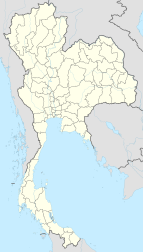Ban Dongphayom
|
Ban Dongphayom บ้านดงพยอม (English: Shorea Forest Village) |
|
|---|---|
| Village | |

House, Ban Dongphayom
|
|
| Coordinates: 16°37′02″N 100°20′56″E / 16.61722°N 100.34889°ECoordinates: 16°37′02″N 100°20′56″E / 16.61722°N 100.34889°E | |
| Country | Thailand |
| Province | Phitsanulok |
| Amphoe | Bang Krathum |
| Tambon | Nakhon Pa Mak |
| Government | |
| • Phu Yai Ban | Lamiet Muenpet |
| Area | |
| • Total | 6.2 km2 (2.4 sq mi) |
| • Agricultural use | 4.3 km2 (1.7 sq mi) |
| Population (2005) | |
| • Total | 678 |
| • Male | 350 |
| • Female | 328 |
| Time zone | ICT (UTC+7) |
| Postal code | 65110 |
| Chief roadway | Unpaved road to Ban Sam Ruen |
| Chief watercourse | Canal to Ban Grong Greng |
Ban Dongphayom (Thai: บ้านดงพยอม) is a village (muban) in the Nakhon Pa Mak sub-district of Bang Krathum District of Phitsanulok Province, Thailand.
The first element ban (Thai: บ้าน) means home or village. The second element dong (Thai: ดง) means forest or jungle. The third element phayom (Thai: พยอม) is a type of rainforest tree of the genus Shorea indigenous to Thailand. While there is no common name for phayom in the English language, Philippine mahogany is a mixture of Shorea genera. A loose translation of the name as a whole would be "phayom wood forest village". There are few phayom trees left in Ban Dongphayom, as villagers have cleared the majority of the land for agriculture over the years. The phayom tree is an endangered species.
Ban Dongphayom lies in the western portion of Nakhon Pa Mak, bordering Ban Sam Ruen. It is on land between the Wang Thong and the Wat Ta Yom Rivers, within the Nan Basin (part of the Chao Phraya Watershed). A canal flows through the village, which leads to Ban Grong Greng, where it joins another canal that joins the Wang Thong River at Ban Sam Ruen.
The current village headman of Ban Dongphayom is Phu Yai Ban Lamiet Muenpet. This position is an elected post, which is then followed by appointment by the Ministry of the Interior.
Ban Dongphayom is a rural agricultural residential village. Resident farmers in Ban Dongphayom are primarily engaged in the business of growing rice. However, most farms are diversified, growing sugar cane, bananas, mangos, papayas, chili peppers, coconuts, spices and herbs. Farmers in Ban Dongphayom also typically raise livestock such as cattle, chicken and pigs. A public pharmacy is also run from one of the homes in Ban Dongphayom which supplies medication to Ban Dongphayom villagers and residents of surrounding villages in Nakhon Pa Mak. Villagers also engage in fishing in the canal which flows through the village. As of 2001, running water had just been installed in Ban Dongphayom, and the water quality was not yet suitable for drinking. Electricity is available and most homes have televisions. Phone lines, however are not installed. Some villagers use mobile phones for communication outside the village. Transportation in and out of the village is over narrow dirt roads. These roads are the primary route for transportation in Ban Dongphayom, although the canal is navigable for small boats. Small bridges such as the bridge at Ban Dongphayom prevent larger vessels from navigating the canal.
...
Wikipedia

